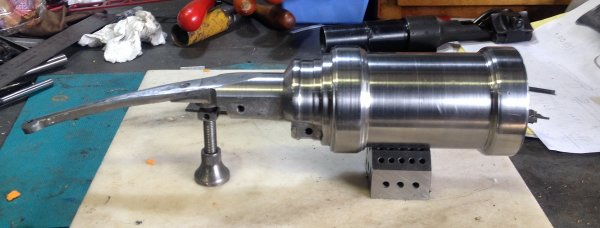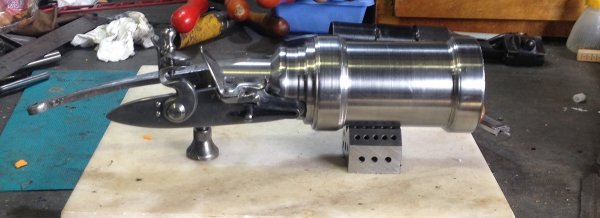So I have started a project I have been thinking about for a long while. The point of it is to gun train bird dogs. So it shoots a racquet ball.
First, an admission. I have never built a flintlock before, although I have built several percussion guns, and lots of cartridge guns. So that is why I went this way. I actually started out planning to do a wheellock, but decided that was more project than I wanted this time. Here is the barrel-
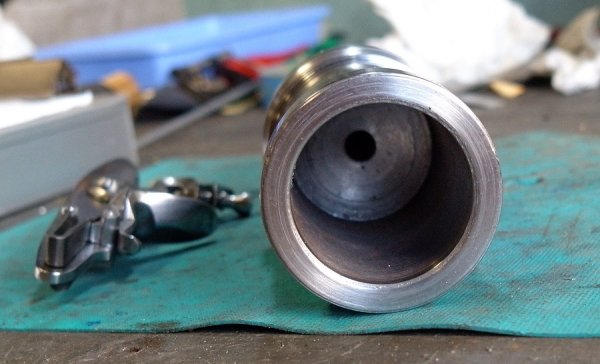
Yes, it is way more stout than it needs to be. At it's thinnest, the barrel wall is just shy of .2" thick. The breech is rounded to match the expected payload, and is further bored at .45". The smaller bore is long enough to put 130gr of powder in, plus a thick patch. I figured that would give me plenty to work with.
Here is the barrel profile as it is now-
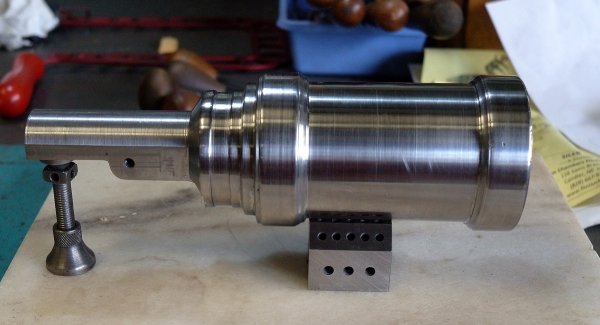
Everything behind the touch hole is solid, and much of that will be cut down when I profile it to match the stock, which I have yet to design. But I do plan to try to stick to a design that is fairly close to mid-1700s German aesthetics. Since I am basically ignorant about flintlocks, I went with a set of Siler castings. I joined this forum to ask some questions about frizzen adjustments, but I read a bunch of old posts and figured those issues out.
Here is the geometry of the lock/barrel so far-
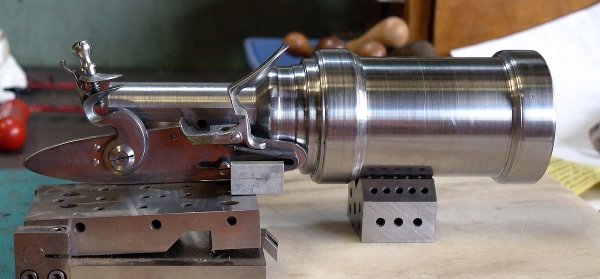
I am probably going to have to mill away some barrel at the front part of the lock so that the priming pan is up against the touch hole. My thinking is that I will run a bolt through the barrel to thread into the front part of the lock. There is plenty of room to do that without interfering with the bore. There is also some room to further contour the lock plate to fit the stock profile. I will be able to taper the barrel tang way down to match that profile as well.
Right now an issue I have is the touch hole. If I put the pan against the barrel flat as it is now, the touch hole is still .3" long. That seems a but much to me. I am toying with the idea of milling an extension of the pan the barrel a bit, but I just don't know if that is wise or necessary. Any input on that issue would be welcomed.
Also, I have tested the lock for firing, and shot balls from the barrel a few times. Since the end use is dog training, I would prefer that the cannon make sound more or less approximating a 12 gauge shotgun. So far, that is not happening, and I did really not expect much bang with 2fg black powder and a rubber ball projectile. I figure I would need a powder formulation that is a bit hotter. I have built the barrel so that it is not going to be the weak point, even if I tried to shoot the heavy iron projectiles that such guns were originally designed for.
I suspect the touch hole liner is the likely weak point. I made a liner out of very hard stainless with a 3/64" hole, but I really don't know what the best practice would be for that. Once again, advice from those with more experience would be welcome.
Anyway, that is where I am at right now.
Cheers- T
First, an admission. I have never built a flintlock before, although I have built several percussion guns, and lots of cartridge guns. So that is why I went this way. I actually started out planning to do a wheellock, but decided that was more project than I wanted this time. Here is the barrel-

Yes, it is way more stout than it needs to be. At it's thinnest, the barrel wall is just shy of .2" thick. The breech is rounded to match the expected payload, and is further bored at .45". The smaller bore is long enough to put 130gr of powder in, plus a thick patch. I figured that would give me plenty to work with.
Here is the barrel profile as it is now-

Everything behind the touch hole is solid, and much of that will be cut down when I profile it to match the stock, which I have yet to design. But I do plan to try to stick to a design that is fairly close to mid-1700s German aesthetics. Since I am basically ignorant about flintlocks, I went with a set of Siler castings. I joined this forum to ask some questions about frizzen adjustments, but I read a bunch of old posts and figured those issues out.
Here is the geometry of the lock/barrel so far-

I am probably going to have to mill away some barrel at the front part of the lock so that the priming pan is up against the touch hole. My thinking is that I will run a bolt through the barrel to thread into the front part of the lock. There is plenty of room to do that without interfering with the bore. There is also some room to further contour the lock plate to fit the stock profile. I will be able to taper the barrel tang way down to match that profile as well.
Right now an issue I have is the touch hole. If I put the pan against the barrel flat as it is now, the touch hole is still .3" long. That seems a but much to me. I am toying with the idea of milling an extension of the pan the barrel a bit, but I just don't know if that is wise or necessary. Any input on that issue would be welcomed.
Also, I have tested the lock for firing, and shot balls from the barrel a few times. Since the end use is dog training, I would prefer that the cannon make sound more or less approximating a 12 gauge shotgun. So far, that is not happening, and I did really not expect much bang with 2fg black powder and a rubber ball projectile. I figure I would need a powder formulation that is a bit hotter. I have built the barrel so that it is not going to be the weak point, even if I tried to shoot the heavy iron projectiles that such guns were originally designed for.
I suspect the touch hole liner is the likely weak point. I made a liner out of very hard stainless with a 3/64" hole, but I really don't know what the best practice would be for that. Once again, advice from those with more experience would be welcome.
Anyway, that is where I am at right now.
Cheers- T








